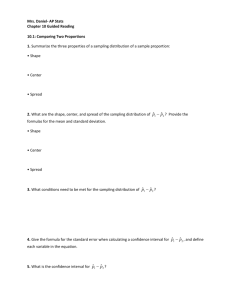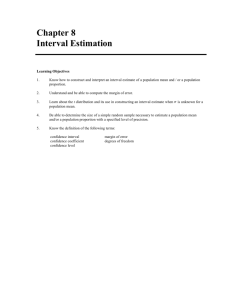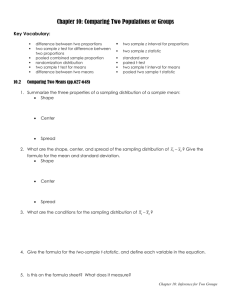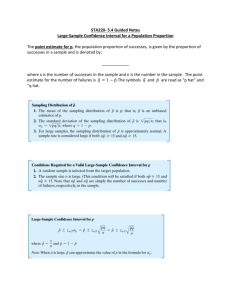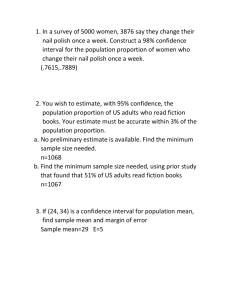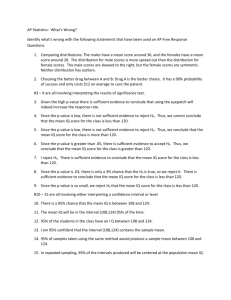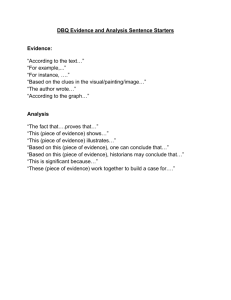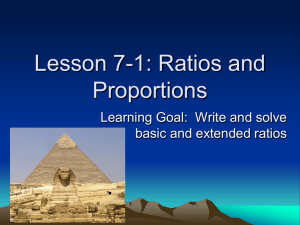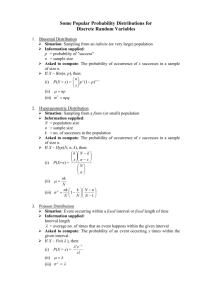Chapter 10 Study Guide Solutions
advertisement
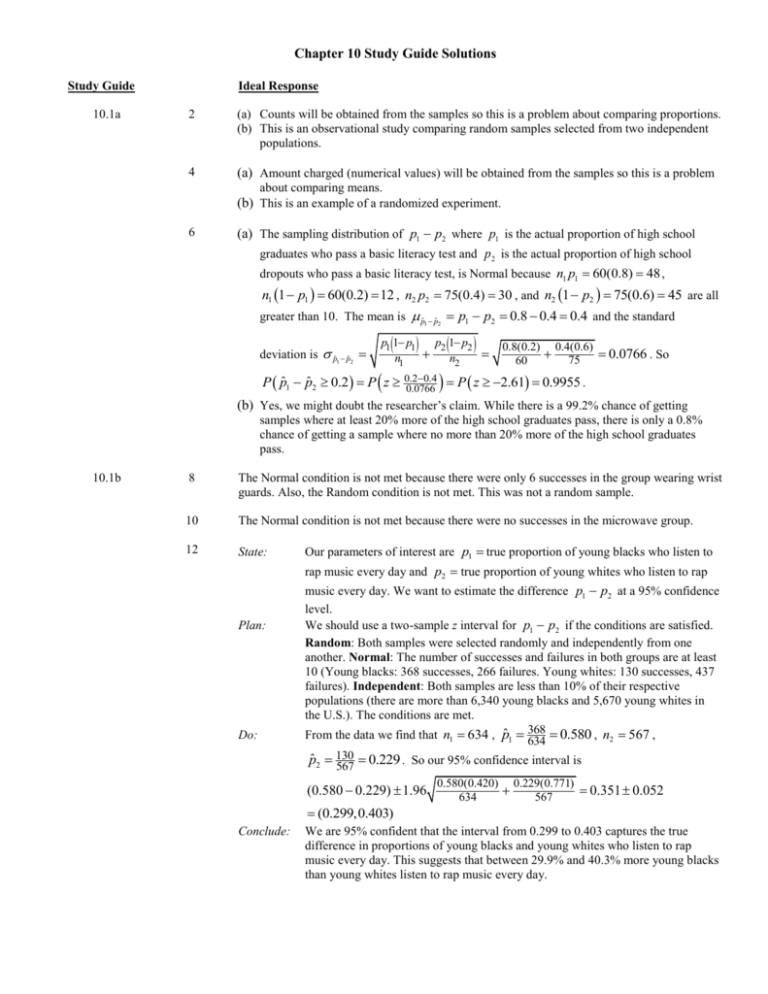
Chapter 10 Study Guide Solutions Study Guide 10.1a Ideal Response 2 (a) Counts will be obtained from the samples so this is a problem about comparing proportions. (b) This is an observational study comparing random samples selected from two independent populations. 4 (a) Amount charged (numerical values) will be obtained from the samples so this is a problem about comparing means. (b) This is an example of a randomized experiment. 6 (a) The sampling distribution of p1 p2 where p1 is the actual proportion of high school graduates who pass a basic literacy test and p 2 is the actual proportion of high school dropouts who pass a basic literacy test, is Normal because n1 p1 60(0.8) 48 , n1 1 p1 60(0.2) 12 , n2 p2 75(0.4) 30 , and n2 1 p2 75(0.6) 45 are all greater than 10. The mean is pˆ1 pˆ 2 p1 p2 0.8 0.4 0.4 and the standard deviation is pˆ1 pˆ 2 p1 1 p1 p2 1 p2 n n1 2 0.8(0.2) 0.4(0.6) 75 0.0766 . So 60 0.4 P pˆ1 pˆ 2 0.2 P z 0.2 0.0766 P z 2.61 0.9955 . (b) Yes, we might doubt the researcher’s claim. While there is a 99.2% chance of getting samples where at least 20% more of the high school graduates pass, there is only a 0.8% chance of getting a sample where no more than 20% more of the high school graduates pass. 10.1b 8 The Normal condition is not met because there were only 6 successes in the group wearing wrist guards. Also, the Random condition is not met. This was not a random sample. 10 The Normal condition is not met because there were no successes in the microwave group. 12 State: Our parameters of interest are p1 true proportion of young blacks who listen to rap music every day and p2 true proportion of young whites who listen to rap Plan: Do: music every day. We want to estimate the difference p1 p2 at a 95% confidence level. We should use a two-sample z interval for p1 p2 if the conditions are satisfied. Random: Both samples were selected randomly and independently from one another. Normal: The number of successes and failures in both groups are at least 10 (Young blacks: 368 successes, 266 failures. Young whites: 130 successes, 437 failures). Independent: Both samples are less than 10% of their respective populations (there are more than 6,340 young blacks and 5,670 young whites in the U.S.). The conditions are met. 0.580 , n2 567 , From the data we find that n1 634 , pˆ1 368 634 pˆ 2 130 0.229 . So our 95% confidence interval is 567 0.580(0.420) 0.229(0.771) (0.580 0.229) 1.96 0.351 0.052 634 567 (0.299,0.403) Conclude: We are 95% confident that the interval from 0.299 to 0.403 captures the true difference in proportions of young blacks and young whites who listen to rap music every day. This suggests that between 29.9% and 40.3% more young blacks than young whites listen to rap music every day. Chapter 10 Study Guide Solutions 14 (a) State: Our parameters of interest are p1 true proportion of older black men who fear crime and p2 true proportion of older black women who fear crime. We want to estimate the difference p1 p2 at a 90% confidence level. Plan: Do: We should use a two-sample z interval for p1 p2 if the conditions are satisfied. Random: Both samples were selected randomly and independent from one another. Normal: The number of successes and failures in both groups are at least 10 (Older black men: 46 successes, 17 failures. Older black women: 27 successes, 29 failures). Independent: Both samples are less than 10% of their respective populations (there are more than 630 older black men and 560 older black women in Atlantic City, NJ). The conditions are met. From the data we find that n1 63 , pˆ1 46 0.73 , n2 56 , pˆ 2 27 0.482 63 56 So our 90% confidence interval is 0.73(0.27) 0.482(0.519) (0.730 0.482) 1.645 0.248 0.143 63 56 (0.105,0.391) Conclude: We are 90% confident that the interval between 0.105 and 0.391 captures the true difference in the proportions of older black men and older black women who fear crime. This interval suggests that between 10.5% and 39.1% more older black men than older black women fear crime. (b) Since the interval does not contain 0, there is convincing evidence that the two proportions are not the same. 10.1c 16 H o : p1 p2 0 versus Ha : p1 p2 0 where p1 is the actual proportion of high school freshman in Illinois who use anabolic steroids and p 2 is the actual proportion of high school seniors in Illinois who use anabolic steroids. 18 (a) State: Plan: Do: We want to perform a test at the 0.5 significance level of the hypotheses stated in Exercise 16. We should use a two-sample z test for p1 p2 if the conditions are satisfied. Random: Both samples were selected randomly and independent from one another. Normal: The number of successes and failures in both groups are at least 10 (Freshmen: 34 successes, 1645 failures. Seniors: 24 successes, 1342 failures). Independent: Both samples are less than 10% of their respective populations (there are more than 16,790 freshmen and 13,660 seniors in Illinois). The conditions are met. The proportions of those using anabolic steroids in each group are 34 0.0203 , p 24 0.0176 . The pooled proportion is ˆ 2 1366 pˆ1 1679 3424 58 0.0190 . The test statistic is pˆ C 1679 1366 3045 z (0.02030.0176)0 (0.019)(0.981) (0.019)(0.981) 1679 1366 0.54 . Since this is a two-sided test the P-value is 2P( z 0.54) 2(0.2946) 0.5892 Conclude: (b) State: Plan: Do: Since the P-value is greater than 0.05, we fail to reject the null hypothesis. We do not have enough evidence to conclude that there is a difference in the actual proportions of freshmen and seniors in Illinois who use anabolic steroids. We want to estimate the difference p1 p2 at a 95% confidence level. We should use a two-sample z interval for p1 p2 if the conditions are satisfied. We checked the conditions in part (a) and they have been met. From the data we find that n1 1679 , pˆ1 0.0203 , n2 1366 , pˆ 2 0.0176 So our 95% confidence interval is 0.0203(0.9797) 0.0176(0.9824) (0.203 0.0176) 1.96 0.0027 0.0097 1679 1366 (0.007,0.0124) Chapter 10 Study Guide Solutions 22 Conclude: We are 95% confident that the interval from –0.007 to 0.0124 captures the true difference in the proportions of freshmen and seniors who use anabolic steroids. This is consistent with our answer to part (a). In both cases we decided that 0 was a plausible value for the difference in the proportions. (a) State: We want to perform a test at the 0.5 significance level of the hypotheses H o : p1 p2 0 versus Ha : p1 p2 0 where p1 is the actual proportion of patients like the ones in the study who would have a stroke when taking aspirin alone and p 2 is the actual proportion of patients like the ones in the study who would have had a stroke when taking both drugs. We should use a two-sample z test for p1 p2 if the conditions are satisfied. Random: This was a randomized comparative experiment. Normal: The number of successes and failures in both groups are at least 10 (Aspirin alone: 206 successes, 1443 failures. Additional medicine group: 157 successes, 1493 failures). Independent: Due to the random assignment, these two groups of patients can be viewed as independent. Individual observations in each group should also be independent: knowing whether one patient had a stroke or not gives no information about another patient. The conditions are met. 206 0.125 , The proportions of stroke victims in each group are pˆ1 1649 157 0.095 . The pooled proportion is p 206157 363 0.11 . ˆ C 1649 pˆ 2 1650 1650 3299 Plan: Do: The test statistic is z (0.1250.095)0 (0.11)(0.89) (0.11)(0.89) 1649 1650 2.75 . Since this is a two-sided test the P-value is 2P( z 2.75) 2(0.003) 0.006 Conclude: Since the P-value is less than 0.05, we reject the null hypothesis. We have enough evidence to conclude that there is a difference in the proportions of patients like the ones in this study who suffer strokes depending on whether they take aspirin alone or take the additional medication as well. (b) A Type I error would be to conclude that there is a difference between the stroke rates for the two treatments when there is no difference and a Type II error would be to conclude that there is no difference between the stroke rates of people on the two different treatments when there actually is. A Type II error would be more serious in this case because we would not market a drug that would reduce the number of strokes that people suffer. 24 10.1 MC (a) We should use a two-sample z test for p1 p2 if the conditions are satisfied. Random: This was a randomized comparative experiment. Normal: The number of successes and failures in both groups are at least 10 (Acupuncture group: 34 successes, 46 failures. Control group: 21 successes, 59 failures). Independent: Due to the random assignment, these two groups of women can be viewed as independent. Individual observations in each group should also be independent: knowing whether one woman became pregnant gives no information about another woman. The conditions are met. (b) If there is no difference in pregnancy rates of women who receive acupuncture and those who don’t, there is a 1.52% chance of seeing as many more pregnancies while receiving acupuncture as we did. (c) Since the P-value was less than 0.05, we reject the null hypothesis. We have enough evidence to conclude that the proportion of pregnancies among women like these who receive acupuncture is higher than for those who do not. (d) This study was not blind. The women who received acupuncture knew that they had received the treatment and those in the control group knew that they had not received the treatment. This may affect their behavior (even unconsciously) in such a way as to affect whether they became pregnant or not. 29. B 30. D 31. B 32. E Chapter 10 Study Guide Solutions 10.2a 36 (a) The sampling distribution of M W where p1 is approximately normal with mean M W M W 69.3 64.5 4.8 inches and the standard deviation is M W M2 W2 (2.8)2 (2.5)2 3.75 . 4.8 P z 0.75 0.7734 . (b) P M W 2 P z 23.75 38 (a) The distribution of xM xW is approximately normal with mean M W M W 69.3 64.5 4.8 inches and standard deviation x M xW 2 M nM W2 nW (2.8)2 16 (2.5)2 9 1.09 inches. 4.8 P z 2.57 0.9949 (b) P xM xW 2 P z 21.09 (c) No. It is almost certain (a 99.49% chance) that the sample mean height for young women is more than 2 inches less than the sample mean height for the young men. 10.2b 58 (a) If people were allowed to choose which group they wanted to be in, it is likely that all those who choose one particular treatment (sleep deprivation, for example) might be systematically different from those who choose to be in the other treatment group. (b) Based on the dotplot from Fathom, a difference of 15.92 between the means is quite rare. Only about 5 out of the 1000 differences were that big. We would conclude that the mean increase in score is significantly higher for those who were allowed to sleep than for those who were sleep deprived. (c) Since we rejected the null hypothesis (of no difference), this could have been a Type I error – rejecting the null hypothesis when it is really true. 39 No. The Normal condition is not met with this data set. There are fewer than 30 observations in each group and the stemplot for Males shows skewness. 40 Yes. The conditions are met. Even though there is an outlier in the South African distribution, the two sample sizes are large enough to make the two-sample t procedures fairly accurate. 41 No. The Independent condition is not met in this data set. We have data from more than 10% of Islamic nations. 42 No. The Random condition was not met in this study. The words chosen from each article were the first words (either 100 or 200) in the article. It may be that the word length differs in different locations in the articles. 44 (a) The centers of the two groups seem to be quite different, with red flowers being longer. The red flowers also seem to have more variability to their lengths. (b) State: Our parameters of interest are 1 the actual mean length of red flowers and Plan: 2 the actual mean length of yellow flowers. We want to estimate the difference 1 2 at a 95% confidence level. We should use a two-sample t interval for 1 2 if the conditions are satisfied. Do: Random: Both samples were randomly selected independently of one another. Normal: Both sample sizes were less than 30. However, the dotplots given in the problem do not indicate serious skewness or large outliers. Independent: Both samples are less than 10% of their respective populations (there are more than 230 red flowers and 150 yellow flowers). The conditions are met. From the data we find that n1 23 , x1 39.698 , s1 1.786 , n2 15 , x2 36.18 , and s2 0.975 . We will use the conservative degrees of freedom which is 14 in this case. So our 95% confidence interval is (36.698 36.18) 2.145 (1.786)2 (0.975)2 15 3.518 0.964 (2.554, 4.482) 23 Chapter 10 Study Guide Solutions Conclude: We are 95% confident that the interval from 2.554 to 4.482 captures the difference in actual mean length of red flowers and yellow flowers. This suggests that the mean length of red flowers is between 2.554 mm and 4.482 mm larger than the mean length of the yellow flowers. (c) Since 0 is not in this interval, it does support the researchers’ belief that the two varieties have different lengths 46 (a) The use of the two-sample t procedure is still justified because the t procedures are robust against non-Normality in the populations with such large samples. (b) State: Our parameters of interest are 1 the actual mean reliability rating of Anglo customers and 2 the actual mean reliability rating of Hispanic customers. We want to estimate the difference 1 2 at a 95% confidence level. Plan: Do: We should use a two-sample t interval for 1 2 if the conditions are satisfied. Random: Both samples were randomly selected independently of one another. Normal: Both sample sizes were at least 30. Independent: Both samples are less than 10% of their respective populations ((there are likely more than 920 Anglo customers of the bank and 860 Hispanic customers of the bank). The conditions are met. From the data we find that n1 92 , x1 6.37 , s1 0.60 , n2 86 , x2 5.91 , and s2 0.93 . We will use the conservative degrees of freedom which is 85 in this case. So our 95% confidence interval is (0.60)2 (0.93)2 (6.37 5.91) 1.988 86 0.46 0.235 (0.225,0.695) 92 Conclude: We are 95% confident that the interval from 0.225 to 0.695 captures the actual difference in mean reliability rating for Anglos and Hispanics. This suggests that the mean reliability rating for Anglos is between 0.225 and 0.695 higher than the mean reliability rating for Hispanics. (c) If we repeatedly took random samples of 92 Anglos and 86 Hispanics and each time constructed a 95% confidence interval in this same way, about 95% of the resulting intervals would capture the actual difference in mean reliability rating. 10.2c 52 (a) Breast-feeding mothers have a lower mean mineral content x1 3.587, s1 2.506 with more variability than other mothers x2 0.309, s2 1.298 . Both distributions appear slightly right-skewed. (b) State: We want to perform a test at the 0.05 significance level of H o : 1 2 0 versus H a : 1 2 0 where 1 the actual mean percent Plan: Do: change in mineral content for breastfeeding women and 2 the actual mean percent change in mineral content for women who were neither pregnant nor lactating. We should use a two-sample t test if the conditions are satisfied. Random: Both samples were selected randomly independently of one another. Normal: Since the number of observations in the control group is less than 30 we check the boxplots. Independent: Both samples are less than 10% of their respective populations (there are more than 470 breastfeeding women and 220 non-pregnant and non-lactating women). The conditions are met. From the data we find that n1 47 , x1 3.587 , s1 2.506 , n2 22 , x2 0.309 , and s2 1.298 . We will use the conservative degrees of freedom which is 21 in this case. The test statistic is t Conclude: ( 3.5870.309)0 (0.60)2 (0.93)2 86 92 8.498 . This is a one-sided test, so the P-value is P(t 8.498) 0 Since the P-value is less than 0.05, we reject the null hypothesis. We have enough evidence to conclude that breastfeeding women have a larger mean percent bone mineral loss than women who are neither pregnant nor lactating. (c) Since this was not a randomized controlled experiment we cannot conclude that Chapter 10 Study Guide Solutions breastfeeding causes bone mineral loss. (d) State: We want to estimate the difference 1 2 at a 95% confidence level. Plan: Do: We should use a two-sample t interval for 1 2 if the conditions are satisfied. We checked the conditions in part (b) and they were met. Using 21 df, our 95% confidence interval is (2.506)2 (1.298)2 (3.587 0.309) 2.080 22 3.896 0.954 47 (4.85, 2.942) Conclude: 53 (a) State: Plan: Do: We are 95% confident that the interval from -4.85 to -2.942 captures the difference in actual mean percent of bone mineral loss in breastfeeding women and nonpregnant and non-lactating women. This interval suggests that the mean percent of bone3 mineral loss in breastfeeding women is between 4.85% and 2.942% more than for women who are neither pregnant nor lactating. This interval not only addresses the plausibility of the two means being the same, but also gives a range of plausible values for the difference in the two means. We want to perform a test at the 0.05 significance level of H o : 1 2 0 versus H a : 1 2 0 where 1 the actual mean number of words spoken per day by female students and 2 the actual mean number of words spoken by male students. We should use a two-sample t testif the conditions are satisfied. Random: Both samples were selected randomly. Normal: Both samples had more than 30 observations. Independent: Both samples are less than 10% of their respective populations (there are more than 560 female students at a large university and 560 male students at a large university). The conditions are met. From the data we find that n1 56 , x1 16,177 , s1 7520 , n2 56 , x2 16,569 , and s2 9108 . We will use the conservative degrees of freedom which is 55 in this case. The test statistic is t (1617716569)0 (7520)2 (9108)2 56 56 0.248 . This is a two-sided test, so the P-value is 2P(t 0.248) 2(0.4025) 08050 Conclude: Since the P-value is greater than 0.05, we fail to reject the null hypothesis. We do not have enough evidence to conclude that male students and female students speak a different number of words per day on average. (b) If males and females speak the same number of words per day on average, then we have about an 80% chance of selecting a sample where the difference between the average number of words spoken per day by males and females is as large as or larger than the difference we actually saw. 10.2 MC 59 (a) Two-sample t test. Each car has a different brand of tire on it. There is no obvious way to pair one observation of a Brand A tire with one observation of a Brand B tire. (b) Paired t test. The subjects are each subjected to both treatments. So we would take the differences in productivity for each subject from when they listened to music and when they didn’t. (c) Two-sample t test. Each person was only given one treatment. Then the two groups were compared. 60 (a) Paired t test. Pairs of pigs who were littermates were used, with one in each pair getting one treatment and the other pig in the pair getting the other treatment. (b) Two-sample t test. There is no connection between the male and female professors. They are not paired in any way. (c) Two-sample t test. The treatments were randomly assigned to the plots. There is no way to pair a plot with one treatment with a plot with the other treatment. 67. D 68. A 69. A 70. B
